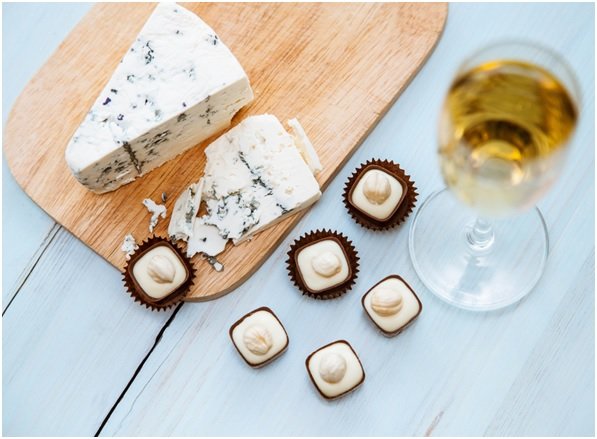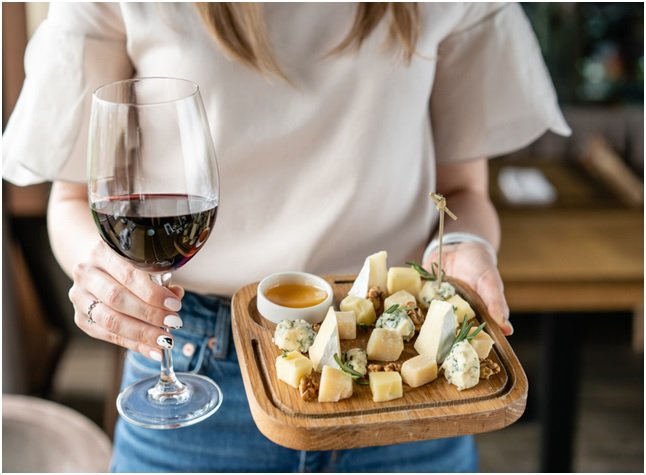Whether you’re preparing to host a high-class dinner party or are looking for an easy way to take your next date night up a few notches, you’re going to want to learn a bit about curating the perfect wine and cheese board. Wine and cheese rank high on our list of favorite foods, so it only makes sense to put them together on a snack board to draw out the complexities in each. Throw in a couple of gourmet chocolate bars and some dainty slivers of Lomo, and you’ve got yourself a five-star charcuterie board your guests won’t soon forget.
New to the cheese board lifestyle? No stress! We’re here to help you put together a top-notch cheese board that’s uniquely designed to pair with your favorite wines.
1. Know the Best Wine and Cheese Pairings — The most important thing to do when designing your cheese board is to figure out what cheeses go with the wines you want to taste and vise-versa. The fact is that both wine and cheese can be complex and robust, so you wouldn’t want to pair them together if they might overpower each other. At the same time, both have the ability to draw out the nuances of flavor in the other, so the right combo can be elevating.
The best way to determine which cheeses go with which wines, of course, is to do a bit of taste-testing for yourself. But here are some tried and true best wine and cheese pairings to get you started:
- Port wine and a stinky cheese like blue stilton
- Merlot with a smooth cheddar or gorgonzola
- Prosecco with an earthy cheese like parmesan or brie
- Sauvignon blanc with aged gouda or cheddar
- Chardonnay with mild, semi-soft cheese like parmesan or Swiss
- Beaujolais with a flavorful aged cheddar or soft brie
2. Add a Sweet Component to the Board — Rich dark chocolate serves a few purposes on your wine and cheese board. First and foremost, it provides a chocolatey, sweet flavor profile to help you detect similar notes in your cheeses and wines. But it can also serve as a palate cleanser if enjoyed between tastes. Be sure to add some broken up squares of gourmet chocolate so your guests can fully experience every note and nuance. If you’re looking to do a wine and cheese board as a gift, be sure to pair it with a chocolate gift box so your recipient gets the full effect.

Source: smallblackcat/Shutterstock.com
3. Label Your Cheeses (and Your Wines) — The worlds of these two food items are vast, varied and complex, which is why a wine or cheese tasting is as much of an educational experience as it is a gastronomic one. If possible, try to label each cheese and provide some background information on both the variety and flavor profile of the cheese and wine. You can make your own cheese markers or buy them online. If you don’t love the idea of printing out informational sheets to provide context on the cheese or wine, bookmark a few pages on your phone and reference the information as you taste.
4. Be Conscious of Palate Fatigue — Palate fatigue, also known as flavor fatigue or taste bud exhaustion, happens when you’re tasting too many flavors in a short period of time. It can prevent you from being able to detect subtleties between food items and may cause everything to temporarily taste the same. To prevent your taste buds from taking a snooze, be sure to have some palate cleansers on hand. As previously mentioned, dark chocolate is a great option, but you could also use sliced pieces of baguette, apples or celery to help keep the buds alive.
5. Choose Complementary Flavors — In general, wine and cheese pair beautifully, and there’s most likely a perfectly drinkable complement to your favorite fromage. But if smooth tasting is what you seek, you may want to avoid certain types of cheeses or flavor profiles. As a general rule, avoid pairing super-pungent cheeses with mild wines, as they can overpower the flavor of the grapes and prevent you from getting the full picture. Instead, try to match flavor intensity — pair mild cheeses with mild wines and intensely flavored cheeses with intense wines.
6. Don’t Skip the Funky Stuff — As you’ll notice when tasting, many of the best wine and cheese pairings involve smooth, delicate and approachable cheeses — cheddar, gouda, parmesan, brie. But that doesn’t mean you should skip over the funky stuff in the cheese aisle. Some experts suggest pairing your funkier cheeses with sweeter wines. Ultimately, your goal should be to highlight the flavors in both components, so just make sure your cheese isn’t drowning out the complexities of your sweeter wines.

Source: nevodka/Shutterstock.com
7. Add a Couple of Extras for Your Vegan Friends — If you want to make sure your cheese board includes something for everyone, be sure to add plenty of crackers, olives, nuts, fruit and pickled veggies to the board for your vegan and plant-based pals. A separate board labeled vegan would be helpful, but be sure to check cracker ingredients for non-vegan milk, butter and lard. If you’ve got a health foods store nearby, scan the aisles for cultured vegan cheese alternatives. Oh, and don’t forget to add a few squares of vegan chocolate to give your board a sweet, plant-based finish.
Our best advice on making a wine and cheese board that everyone will adore? Let your guests experiment with lots of different flavor pairings. Set out several different wine and cheese options and encourage everyone to mix and match as they desire. You might just discover a new pairing that knocks your socks off!
